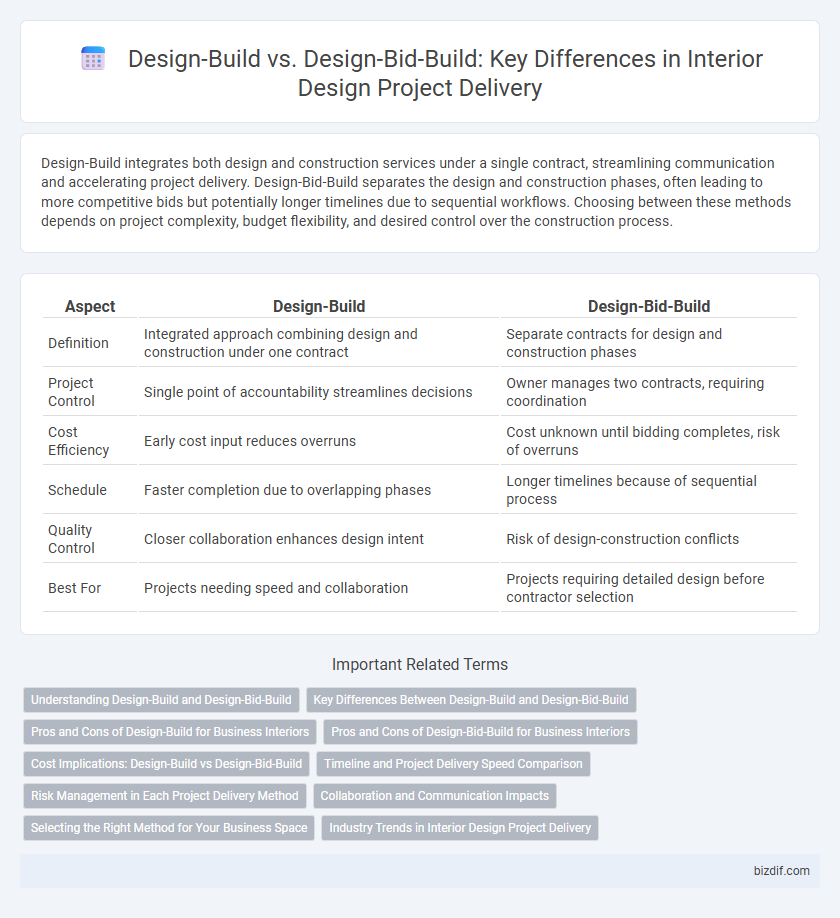Design-Build integrates both design and construction services under a single contract, streamlining communication and accelerating project delivery. Design-Bid-Build separates the design and construction phases, often leading to more competitive bids but potentially longer timelines due to sequential workflows. Choosing between these methods depends on project complexity, budget flexibility, and desired control over the construction process.
Table of Comparison
| Aspect | Design-Build | Design-Bid-Build |
|---|---|---|
| Definition | Integrated approach combining design and construction under one contract | Separate contracts for design and construction phases |
| Project Control | Single point of accountability streamlines decisions | Owner manages two contracts, requiring coordination |
| Cost Efficiency | Early cost input reduces overruns | Cost unknown until bidding completes, risk of overruns |
| Schedule | Faster completion due to overlapping phases | Longer timelines because of sequential process |
| Quality Control | Closer collaboration enhances design intent | Risk of design-construction conflicts |
| Best For | Projects needing speed and collaboration | Projects requiring detailed design before contractor selection |
Understanding Design-Build and Design-Bid-Build
Design-Build integrates both design and construction phases under a single contract, streamlining communication and accelerating project timelines. Design-Bid-Build separates design and construction into two distinct contracts, often leading to longer schedules but offering competitive bidding and clearer cost definitions. Choosing between these methods depends on project complexity, budget constraints, and the desired level of collaboration between designers and builders.
Key Differences Between Design-Build and Design-Bid-Build
Design-Build integrates both design and construction services under a single contract, enabling streamlined communication and faster project completion. In contrast, Design-Bid-Build separates the design and construction phases, requiring owners to contract individually with architects and contractors, which can extend timelines and increase the risk of miscommunication. Cost control is often more predictable in Design-Build due to early collaboration, while Design-Bid-Build offers clearer initial design scope but may encounter change orders during construction.
Pros and Cons of Design-Build for Business Interiors
Design-build for business interiors streamlines project delivery by integrating design and construction, reducing timelines and minimizing communication errors, which enhances efficiency and cost control. This approach fosters collaboration between architects and contractors from the outset, leading to innovative solutions tailored to client needs, but it may limit competitive bidding, potentially affecting price transparency. Owners benefit from a single point of accountability, though the reduced checks and balances can increase risks if the chosen design-build firm lacks comprehensive expertise.
Pros and Cons of Design-Bid-Build for Business Interiors
Design-Bid-Build offers clear separation between design and construction phases, allowing businesses to select contractors through competitive bidding, which can lead to cost savings and transparency. However, this method often results in longer project timelines and potential conflicts between designers and contractors due to fragmented responsibilities. For business interiors, these challenges can delay workspace functionality, impacting operational efficiency and budget predictability.
Cost Implications: Design-Build vs Design-Bid-Build
Design-Build streamlines project delivery by integrating design and construction, often reducing overall costs through enhanced collaboration and fewer change orders. Design-Bid-Build typically involves separate contracts for design and construction, which can lead to higher costs due to increased administrative overhead and potential for project delays. Cost predictability is generally better in Design-Build because budgeting occurs with contractor input early in the process, minimizing unforeseen expenses.
Timeline and Project Delivery Speed Comparison
Design-Build consolidates design and construction phases by involving a single entity, significantly reducing project timelines and accelerating delivery speed compared to traditional methods. Design-Bid-Build separates design and bidding stages, often causing delays due to sequential workflows and potential bid disputes. Interior design projects benefit from Design-Build's streamlined communication and parallel tasks, enabling faster completion and improved efficiency.
Risk Management in Each Project Delivery Method
Design-Build offers streamlined risk management by consolidating design and construction responsibilities under one contract, reducing potential conflicts and enhancing communication efficiency. Design-Bid-Build separates design and construction phases, increasing risk exposure due to fragmented accountability and potential disputes between designers and contractors over project scope or costs. Effective risk mitigation in Design-Bid-Build requires clear contracts and rigorous oversight, while Design-Build relies on integrated teams and collaborative problem-solving to minimize delays and budget overruns.
Collaboration and Communication Impacts
Design-Build fosters seamless collaboration and communication by integrating design and construction teams from project inception, streamlining decision-making and reducing misunderstandings. Design-Bid-Build often results in fragmented communication between separate entities, causing delays and increased potential for errors during handoffs. Efficient collaboration in Design-Build enhances project adaptability and aligns interior design goals with construction realities, improving overall client satisfaction.
Selecting the Right Method for Your Business Space
Choosing between Design-Build and Design-Bid-Build methods impacts cost efficiency, timeline, and project control in interior design projects. Design-Build integrates design and construction services, fostering collaboration and faster completion, ideal for businesses seeking streamlined communication and reduced risks. Design-Bid-Build separates design and construction phases, offering competitive bidding advantages and more client control, suitable for firms prioritizing budget transparency and detailed design inputs.
Industry Trends in Interior Design Project Delivery
The interior design industry increasingly favors the Design-Build model for project delivery due to its streamlined communication and faster timelines, reducing costly revisions and enhancing collaboration between architects, designers, and contractors. Design-Bid-Build remains prevalent for projects requiring clear separation between design and construction phases, often seen in public sector work or where competitive bidding is mandated. Emerging trends highlight the integration of digital tools like Building Information Modeling (BIM) and virtual reality, which are enhancing transparency and efficiency in both delivery methods, but significantly accelerating the Design-Build process.
Design-Build vs Design-Bid-Build Infographic

 bizdif.com
bizdif.com